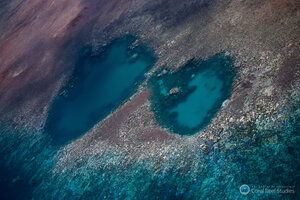Great Barrier Reef bleaching could be final 'wake-up call' for climate action
Extensive bleaching has been caused by higher ocean temperatures. To prevent further damage, governments should commit to lowering emissions, an Australian team says.

The Great Barrier Reef is experiencing the worst bleaching event in 15 years, Australian scientists announced Tuesday after conducting aerial surveys of more than 500 coral reefs from Cairns to Papua New Guinea.
Terry Hughes/ARC Centre of Excellence for Coral Reef Studies
News that 95 percent of the northern Great Barrier Reef is suffering extreme coral bleaching may be the Australian government's final wake-up call, climate scientists warned Tuesday, if it is to preserve the Earth's largest single structure made by living organisms.
“This has been the saddest research trip of my life,” James Cook University professor Terry Hughes, the convener of the National Coral Bleaching Taskforce, said in a press release after the team aerially surveyed almost 2,500 miles of the northern reefs.
Although the northern sections are considered most pristine, only four reefs out of the hundreds they studied between Cairns, Australia, and Papua New Guinea had escaped bleaching, making it the worst bleaching event on record. Previous events in 1998 and 2002 did not impact more than 20 percent.
And there may be more. The Taskforce will try to determine the southern limit of bleaching this week. But while Minister for the Environment Greg Hunt sounded optimistic last week, pointing out that “the bottom three quarters of the reef is in strong condition,” the Taskforce sees it differently.
"It was devastating to look at out of the chopper window and see reef after reef destroyed by bleaching. But really my emotion is not so much sadness as anger," Professor Hughes told the Australian Broadcasting Corporation. "I'm really angry that the government isn't listening to the evidence that we're providing them since 1998."
Coral bleaching is a modern phenomenon, marine scientists say; Over the past 400 years, there's no evidence of bleaching events until the late 20th century. Changing environmental factors like rising sea temperatures can cause the coral to expel their photosynthetic algae, called zooxanthellae, making many turn stark white. Others remain vivid, but have lost the green and brown hues that signal health. Without the symbiotic algae to process sunlight into oxygen and other nutrients, the coral dies.
Some could recover if temperatures drop, but it would still be a decade-long process. Underwater surveys suggest that half of the impacted coral has already died, the team says. But the northern reef is otherwise one of the healthiest sections, so it may stand a better chance of eventually bouncing back. Southern sections have "dodged a bullet" thanks to cooler temperatures, according to Hughes.
A long-term solution requires long-term commitment to reducing climate change, such as lowering greenhouse gas emissions, the team says.
"What we're seeing now is unequivocally to do with climate change," University of Queensland professor Justin Marshall told the ABC. "I guess what upsets me the most is that we are literally stealing the future from our children.... I probably won't see the possible end of the Great Barrier Reef. But it's possible that my grandchildren will."
The World Wildlife Fund called for Prime Minister Malcolm Turnbull to survey the bleaching, and see "the face of climate change," spokesman Nick Heath told the Sydney Morning Herald. "We can have our corals, or we can have our complacency. If we don't start to see some real leadership on the Reef, it will be gone."

